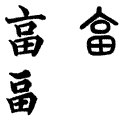
Fu2. Abundance. ...the character means gao1 [high, tall] (contracted), the heaping up of the productions of the fields (tian2), goods of the earth, abundance, prosperity...Note the modern deformation.... (page 193, Lesson 75 D)
The Garden of Eden page is the second of five pages that attempt to
relate
the forms of Chinese characters to ideas from the Book of Genesis.
Actually, the right side of the character is simply the phonetic element, and we see that, according to Wieger, the two top elements of the phonetic are not "first" and "man", anyhow.

Fu2. Abundance. ...the character means gao1 [high, tall]
(contracted),
the heaping up of the productions of the fields (tian2), goods
of
the earth, abundance, prosperity...Note the modern deformation....
(page
193, Lesson 75 D)
According to Wieger, the upper element is not "two", but is the original version of shang4, "top; upper".

Yuan2. That which is on top (shang4), upon man (ren2).
Head, principle, origin, as "caput" in Latin.
However, the preceding character, yuan2, is simply the
phonetic element of wan2. (For the sceptical, it might be worth
noting that these two characters share identical pronunciations in
Sino-Japanese, in Cantonese,
and in Jian'ou.)
According to Wieger and Karlgren, the appears to be another case of
misidentifying
a semantic-phonetic character as compound indicative. Still, it's worth
looking
at the element that they identify as meaning "secretly". The character
that
they are referring to is pronounced si4. Here's what Wieger has
to
say about it:
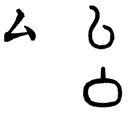
Si4. A cocoon. It represents a silkworm that coils itself up,
and
shuts itself up in its cocoon. By extension, selfish, to care only for
one's
self, separation, private, particular.
This is all very well and good, although taking "privately" to mean
"secretly"
might be a bit of a stretch. Unfortunately, there are several other
characters
which have come to be written in exactly the same modern form. Here
they
are:
![]()
Qu1. Basin, porringer. This representation is found in more
intricate
characters designating different vessels.

Gong1. It was at first a rudimental representation of the arm
bent.
Next we have a single seal-style element that appears in four very different shapes in various compounds:
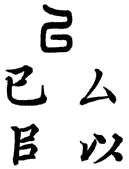
Yi3. This very ancient character is supposed to represent the
exhalation
of the breath, the virtue that emanates from any object, its action,
its
use. By extension, use till exhaustion, to terminate, to decline, to
have
done with, to be no more, passed. NOTE: Yi3 is uniform
in the
ancient writing. In the modern writing, it is different ways that we
shall
explain successively.
Finally, we get to the question of which form is used in the right side of the character shi3.

Yi2. The mouth exhaling a breath (yi3). By extension, to
speak
in order to make one's self known; I, one's self. It is used as an
arbitrary
abbreviation of tai2 (platform, terrace).
Yi2 seems a bit of a stretch as the phonetic element for a character pronounced shi3, but Karlgren reconstructs the Old Chinese of yi2 as something like [dj@g] and shi3 as something like [Sj@g]. (@ represents the schwa in ASCII IPA.)
This shows just how difficult it can be to figure out the origins of
a
Chinese character. It requires a depth of knowledge that is lacking on
The
Genesis Site--or, at least lacking in the sources from which their
information
is derived. (I don't know much, myself, but at least I know where to
look
for the facts.)
A part of the modern character is fu4. Here's what Wieger has to say about these two characters:
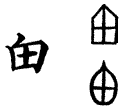
Fu4. Head of a devil; of a phantom. It forms
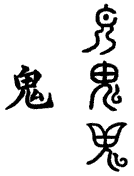
Gui3. The spirit of a ded man, a manes, a ghost, a spectre.
Further,
after the introduction of Buddhism, it meant a devil, a preta. The old
character
[at the upper right] is evidently a primitive representing a human form
floating
in the air. The more recent forms often show the split head of Buddhist
pretas,
and always have an appendage, that was sometimes taken for a tail, but
that
really represents the whirling made by the ghost, while it moves.
As usual, appearances are deceiving. The two trees are not originally trees at all. Furthermore, the "covering" and the "two trees" together are pronounced ma2, and are the phonetic element of mo2. Here are the details for ma2, one element at a time:
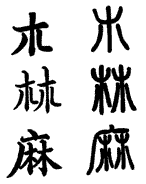
Pan4. To strip hemp and divide (ba1) the fibres from the
stalk
(che4). The modern form is to be distinguished from mu4,
tree.
Pai4. Textile fibres. Not to be confounded with lin2 (forest-two trees), that comes from mu4.
Ma2. Prepared hempen tow, kept under a shelter.

Zhi4. A primitive. It represents a feline, a head with whiskers,
paws,
backbone. Feline beasts, that are characterized by their back long and
supple,
by their undulating gait, e.g. the cat, say the Glose.
The Creation The Fall The Flood The Tower of Babel
Back to the Chinese Characters and Genesis Home Page
![]() Back to RaccoonBend.com Home
Page
Back to RaccoonBend.com Home
Page